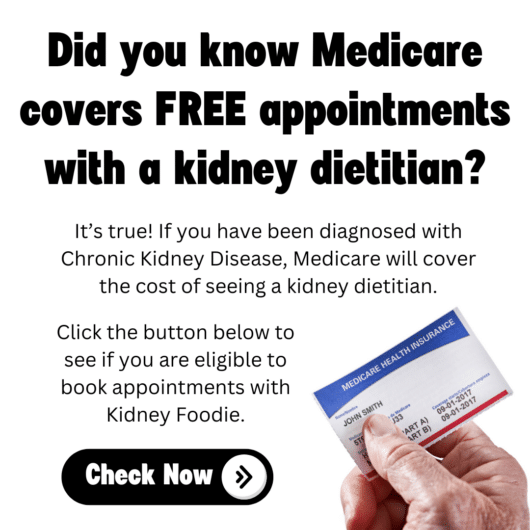Peanut butter is hands down one of my favorite foods – both personally and for people with kidney disease. I’m going to start this post off by answering some FAQs about peanut butter, and then wrap up with some additional reasons why peanut butter is AMAZING.
This post may contain affiliate links through which we may earn a small commission to help keep this website free.
Skip the ads: Kidney Foodie Academy members can access ALL of the Kidney Foodie Grocery Shopping Guides ad-free by visiting this section of the library. Not a member? Learn more about Kidney Foodie Academy here.
Table of contents
How much protein is in peanut butter?
One serving of peanut butter, which is 2 tablespoons, contains 7g of protein. Peanuts are the highest protein nut, so peanut butter is my favorite nut butter to recommend for people on dialysis who have higher protein needs. However, peanut butter can also be great for people not on dialysis who have lower protein needs as long as they keep their portions under control and pair it with lower protein foods.
Is peanut butter high in phosphorus?
No, peanut butter is not considered a high phosphorus food. I repeat – PEANUT BUTTER IS NOT A HIGH PHOSPHORUS FOOD!
For years and years, peanut butter was on the “DO NOT EAT” list for so many people with kidney disease. Everyone considered it too high in phosphorus, and you will find peanuts (and other nuts) being bashed on countless websites and handouts that are still pushing outdated and false information.

But fortunately for us, we’ve learned that the phosphorus in peanuts isn’t well absorbed. Peanuts contain a compound called phytate. Phosphorus found in foods containing phytate cannot be fully absorbed because humans lack the appropriate digestive enzymes to break down phytate.
In fact, it is estimated that we can only absorb about 30% of the phosphorus that is in peanuts. If you want to watch a great video explaining how peanuts are not a high phosphorus food, check out this video we posted on youtube.
Another great thing about peanut butter is that peanut butter almost never contains phosphorus additives. Phosphorus additives are the real culprit for high phosphorus levels, and if you watch that video I just mentioned, you’ll learn how to spot phosphorus additives too.
The only exception is reduced fat peanut butter. I’ve come across several reduced fat peanut butters that contain phosphorus additives, so I recommend avoiding those. I generally recommend avoiding the low fat or reduced fat version of any kind of food. Reduced fat foods are almost always higher in sodium and much more likely to contain harmful phosphorus additives (not to mention they usually taste worse!).
Is peanut butter high in potassium?
No, peanut butter should not be considered a high potassium food because it typically has less than 200mg of potassium per serving and has a very low potassium density.
Many kidney professionals consider a food to be low in potassium if it contains less than 200mg of potassium per serving. One serving of peanut butter is two tablespoons, and two tablespoons of peanut butter can have anywhere from 185mg to 201mg of potassium per serving, so while some peanut butter is technically over 200mg, it is not by much.
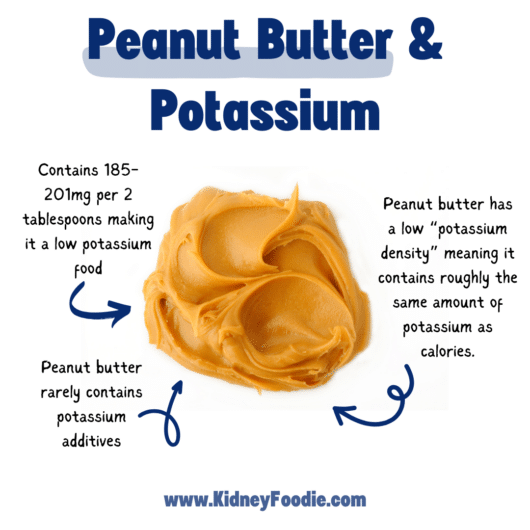
The 200mg rule of thumb can also be very misleading, because that rule ignores how many calories are in a food. For example, one serving of peanut butter, which is two tablespoons, contains 190 calories and 184mg of potassium. If you ate 10 servings of peanut butter, then you would eat 1900 calories and only 1,840mg of potassium. That would be a full day’s worth of calories, but still a very low amount of potassium overall (and just FYI, I am NOT suggesting that you live off of peanut butter).
Meanwhile, a half cup of apple juice contains 151mg of potassium and only 57 calories. You would have to drink more than 33 half cup servings of apple juice to get to 1900 calories. That same amount of apple juice would contain 4,983mg of potassium – which is a lot of potassium for one day! Yet, everyone says apple juice is a low potassium juice because they only look at the 200mg cut off.
The concept of comparing the potassium in a food to the calories in a food can be referred to as potassium density. Divide the potassium by the number of calories to get a potassium density. Using apple juice as the example, it would have a potassium density of 2.6 [ 151mg of potassium divided by 57 calories = 2.6]. Peanut butter would have a potassium density of roughly 1.
The higher the potassium density, the more likely a food is to be considered a high potassium food. The lower the potassium density, the less likely a food is to be considered a high potassium food. Using potassium density to evaluate foods is especially helpful with higher calorie foods and meals. Although there is no official cutoff for ideal potassium density of a food or meal, I would say that anything that contains more calories than mg of potassium (so a potassium density of 1 or less) is definitely a low potassium food.

Is peanut butter high in sodium?
No, peanut butter is considered a low sodium food. In all of my experience reading food labels, I don’t think I’ve ever come across a high sodium peanut butter.
A typical serving of peanut butter has 190 calories and only 140 mg of sodium. If a food contains less sodium than calories, it is considered a low sodium food. If you shop around and compare labels, you may find a peanut butter option that is even lower in sodium.
Is peanut butter good for diabetes?
Yes, peanut butter is a great option for people who have kidney disease and diabetes. Peanut butter is high in fat and relatively low in carbohydrates. A single serving of peanut butter typically has only 8 grams of carbs per serving and 2 grams of fiber.
Most peanut butter contains added sugar. If you are trying to limit added sugar in your diet, then I recommend looking for a ‘natural’ peanut butter. These will typically have no added sugar to them (but not always, so always check the food labels).
Funny story – I was a picky eater and refused to eat peanut butter as a kid. I finally tried it when I was in college and became instantly hooked. I couldn’t stop eating it. It was as if my body was trying to make up for two decades worth of missed peanut butter. I decided that I had to find a way to stop eating so much peanut butter, so I switched to the natural kind. I figured that since it didn’t seem to taste as good, I wouldn’t eat so much!
Well, it only took about two weeks before my taste buds adjusted and decided that natural peanut butter was also super tasty, so I was back to eating spoonfuls of peanut butter straight from the jar! My point with this story is that you may think that the natural peanut butter is gross at first, but I promise that taste buds can (and will!) adjust.
Also – if you decide to make a peanut butter sandwich and enjoy putting jelly on your sandwich, I just recommend checking for a sugar free option to keep the added sugar down.
Is peanut butter good for kidneys?
Yes, peanut butter is an excellent food choice for people with kidney disease. Here are some of the MANY reasons that I highly recommend peanut butter:
- Peanut butter is a good source of plant based protein – just watch your portions if you are on a lower protein diet.
- Peanut butter is low in phosphorus and almost never contains phosphorus additives.
- Peanut butter is low in sodium
- Peanut butter is cheap – even store brands will be low in sodium and phosphorus!
- Peanut butter is portable – peanut butter requires no refrigeration and is shelf stable. It is a perfect food to pack on the go!
- Peanut butter is convenient – you can find peanut butter just about ANYWHERE. Grocery stores, gas stations, convenience stores, dollar stores, the airport – it’s everywhere! If you’re out and about and need a kidney friendly meal or snack, skip the fast food and buy yourself some peanut butter. Peanut butter and an apple or peanut butter on a kidney friendly bread such as this one from Pepperidge Farm are the perfect fast food for someone with kidney disease.
- Eating more nuts is associated with reduced mortality in people with Chronic Kidney Disease. (Source)
Peanut Butter Sandwich
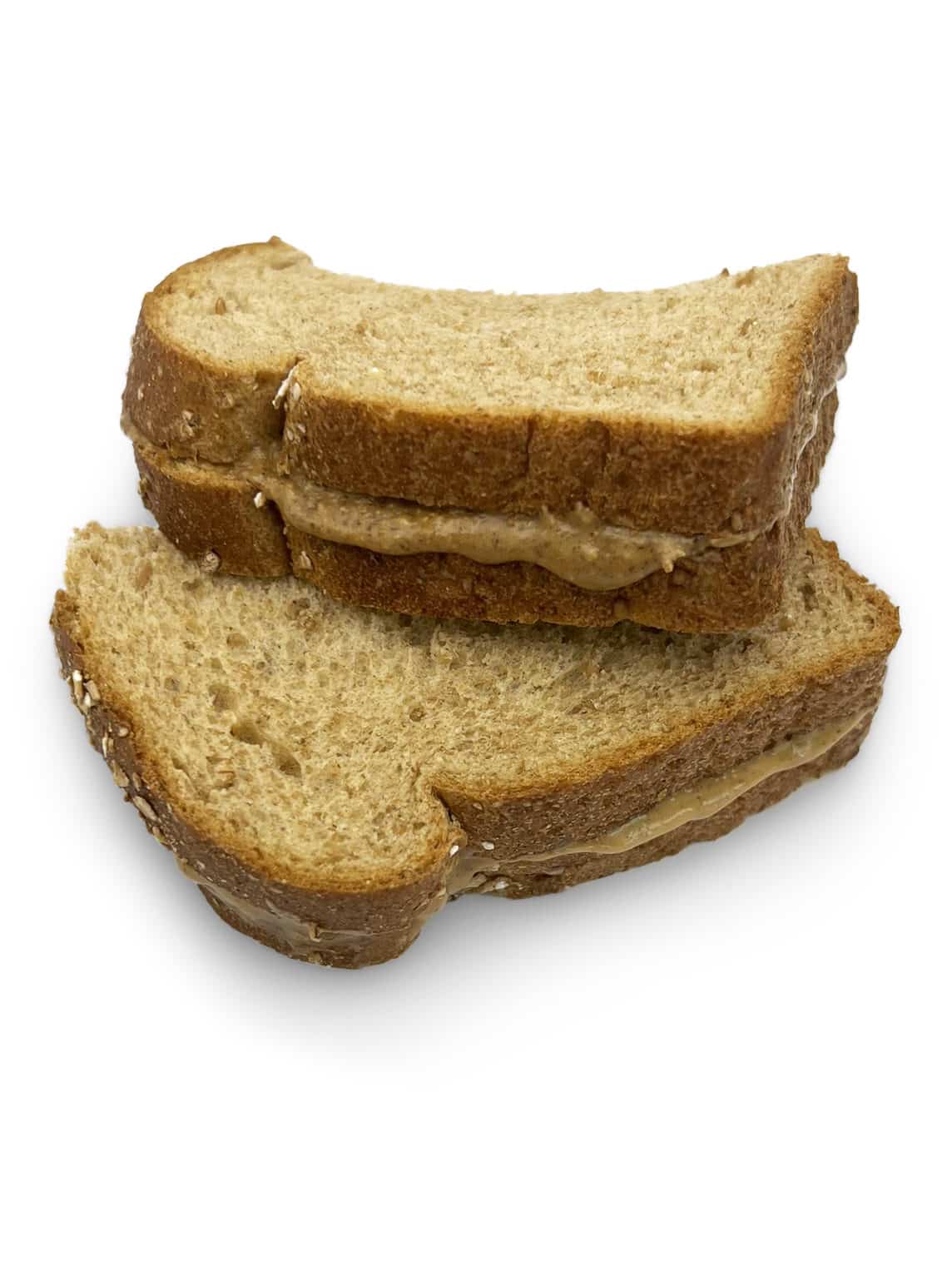
- Calories: 541
- Protein: 21g
- Carbohydrate: 49g
- Fat: 27g
- Sodium: 370mg
- Phosphorus
Additives: None - Potassium: 490mg
- Calcium: 81mg
- Fiber: 11g
- Sugar: 8g
Kidney Friendly Peanut Butter You Can Buy
This is NOT an exhaustive list of all the kidney friendly peanut butter you can buy since just about all peanut butter on the market is kidney friendly (except reduced fat – AVOID that!). However, I wanted to highlight some of the more portable options since not everyone wants to carry around a whole jar of peanut butter with them (I’ve definitely done this before though).
Justin’s Peanut Butter Packets
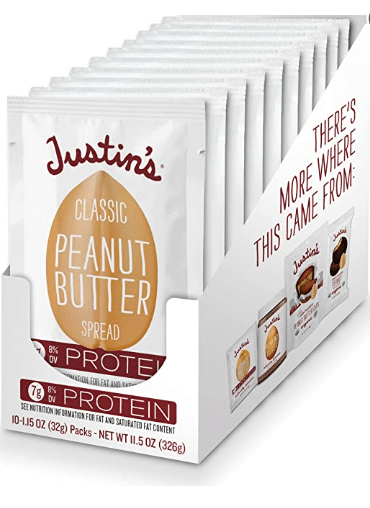
- Calories: 210
- Protein: 7g
- Carbohydrate: 6g
- Fat: 18g
- Sodium: 25mg
- Phosphorus
Additives: None - Potassium: 90mg
- Calcium: 0mg
- Fiber: 1g
- Sugar: 2g
Skippy Natural Peanut Butter Squeeze Pouches
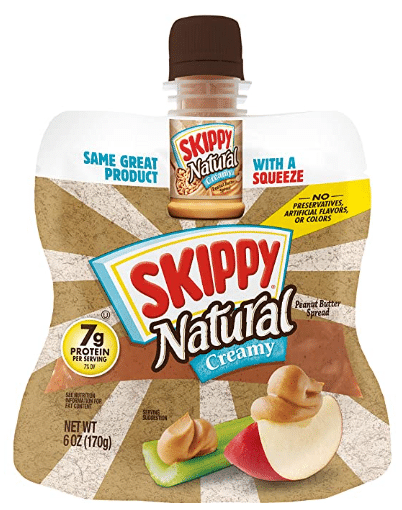
- Calories: 190
- Protein: 7g
- Carbohydrate: 6g
- Fat: 16g
- Sodium: 150mg
- Phosphorus
Additives: None - Potassium: 90mg
- Calcium: 0mg
- Fiber: 1g
- Sugar: 3g
JIF Natural To Go Cups

- Calories: 250
- Protein: 10g
- Carbohydrate: 11g
- Fat: 20g
- Sodium: 105mg
- Phosphorus
Additives: None - Potassium: 251mg
- Calcium: 23mg
- Fiber: 3g
- Sugar: 5g
